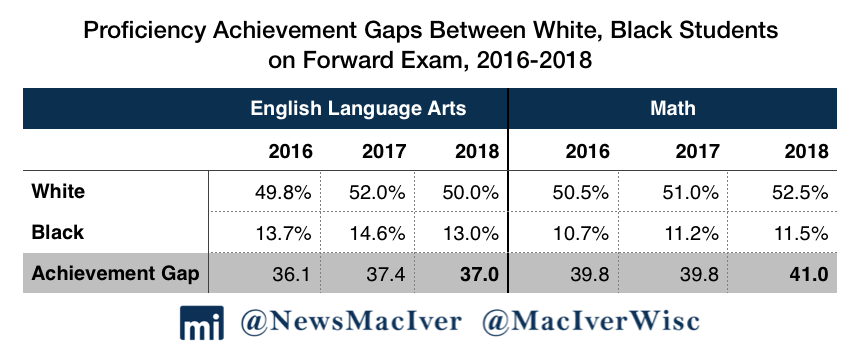 [bctt tweet=”The data release also showed that students in the parental choice programs outperformed their public school peers on the ACT for the third year in a row. #wiedu #wiright #SchoolChoice” username=”MacIverWisc”]
[bctt tweet=”The data release also showed that students in the parental choice programs outperformed their public school peers on the ACT for the third year in a row. #wiedu #wiright #SchoolChoice” username=”MacIverWisc”]
Statewide proficiency on Forward Exam falls to 42 percent in English, increases to 44 percent in math
October 2, 2018
By Ola Lisowski
A new data release from Wisconsin’s Department of Public Instruction shows that 42.4 percent of 3rd to 8th grade students are proficient in English language arts, and 43.8 percent are proficient in math.
Students improved in math by one percentage point over last year, when 42.8 percent were proficient. At the same time, they fared worse in English language arts. Last year, 44.4 percent of students were proficient on the same exam.
Students showed slight improvement in science, with 49.9 percent of students demonstrating proficiency. That’s up a hair from 49.7 percent last year. They also improved on social studies — 50.6 percent of students are proficient in the subject, up a full percentage point from last year’s result.
2018 marks the third year that students have taken the Forward Exam, after the state switched between three exams in three years.
The exam was taken by more than 715,000 Wisconsin students in public and private schools this past spring. Of the students taking the test, more than half are 3rd through 8th graders who take only math and English language arts. Another 196,100 students in grades four, eight, and ten take social studies. Finally, 130,100 students in grades four and eight take the science section.
Achievement gaps persisted in the data, especially between white and black students. The English language arts gap shrank slightly to 37 points, while the achievement gap in math increased from 39.8 points to 41 points.
Choice Students Outperform on ACT
The data release also showed that students in the parental choice programs outperformed their public school peers on the ACT for the third year in a row.
Students in the Wisconsin Parental Choice Program (WPCP), also known as the statewide choice program, earned an average of 21.0 out of 36 points on the ACT Exam. Wisconsin students as a whole earned a score of 19.8 out of 36, lower than last year’s average of 20.0 points.
Participants in the Milwaukee Parental Choice Program (MPCP) earned a composite score of 17.2 out of 36 on the ACT Exam. Economically disadvantaged students at Milwaukee Public Schools earned a score of 15.5, while MPS students as a whole earned 16.1 points.
Typically, outcomes in the choice programs are compared with economically disadvantaged students in public schools, since participation in Wisconsin’s choice programs is limited to impoverished students.
In the 2018-19 school year, families of four can earn a maximum of $73,800 annually to be eligible for the school choice program in Milwaukee or Racine — 300 percent of the federal poverty level. In the statewide program, the income cap is set at $54,120, or 220 percent of the federal poverty line.
Students in the Racine Parental Choice Program (RPCP) earned an average of 19.4 out of 36 points on the ACT. Economically disadvantaged Racine Unified students earned a score of 16.0, while RUSD students as a whole earned 17.2 points.
Jim Bender, President of School Choice Wisconsin, celebrated the results in a statement.
“The school choice programs outperformed their peers for the third year in a row on the ACT,” Bender said. “Higher scores. Lower cost. The continued growth of the programs is good for students and taxpayers in Wisconsin.”
Overall, approximately 66,300 students in 11th grade took the ACT this spring, paid for by the state of Wisconsin. Before offering the exam at no cost to students, about 72 percent of Wisconsin graduates took the exam. Wisconsin now has one of the highest participation rates for the ACT in the country.
ACT Aspire Shows Mixed Results
Students also showed slight improvements on the ACT Aspire, a type of “pre ACT” exam taken by freshmen and sophomores in high school to prepare them for the full ACT that they’ll use on college applications. This year, 58.3 percent of students were proficient in English on the ACT Aspire, up from 57.5 percent last year.
The same was true on the math section of the ACT Aspire, where 39.7 percent of students are now considered ready or exceeding, up from 37.1 percent in 2017.
Students fared worse in reading, with 36.8 percent showing proficiency in that subject, down from 38.6 percent last year. Scores also fell slightly on the science section, with 35.1 percent ready or exceeding, down a tick from 35.5 percent in 2017.
A DPI press release described the results as holding steady, with “some promising gains in mathematics achievement across most grade levels.” Third graders, the youngest students to take the test, showed the most striking improvements over last year. In English language arts, 39 percent of third grade students were proficient, up from 41.1 percent last year. Those students also improved in math, with 49 percent showing proficiency, up from 47.3 percent in 2017.
The data comes just over a month ahead of the release of Wisconsin’s latest school and district report cards, which are slated for a November release.


